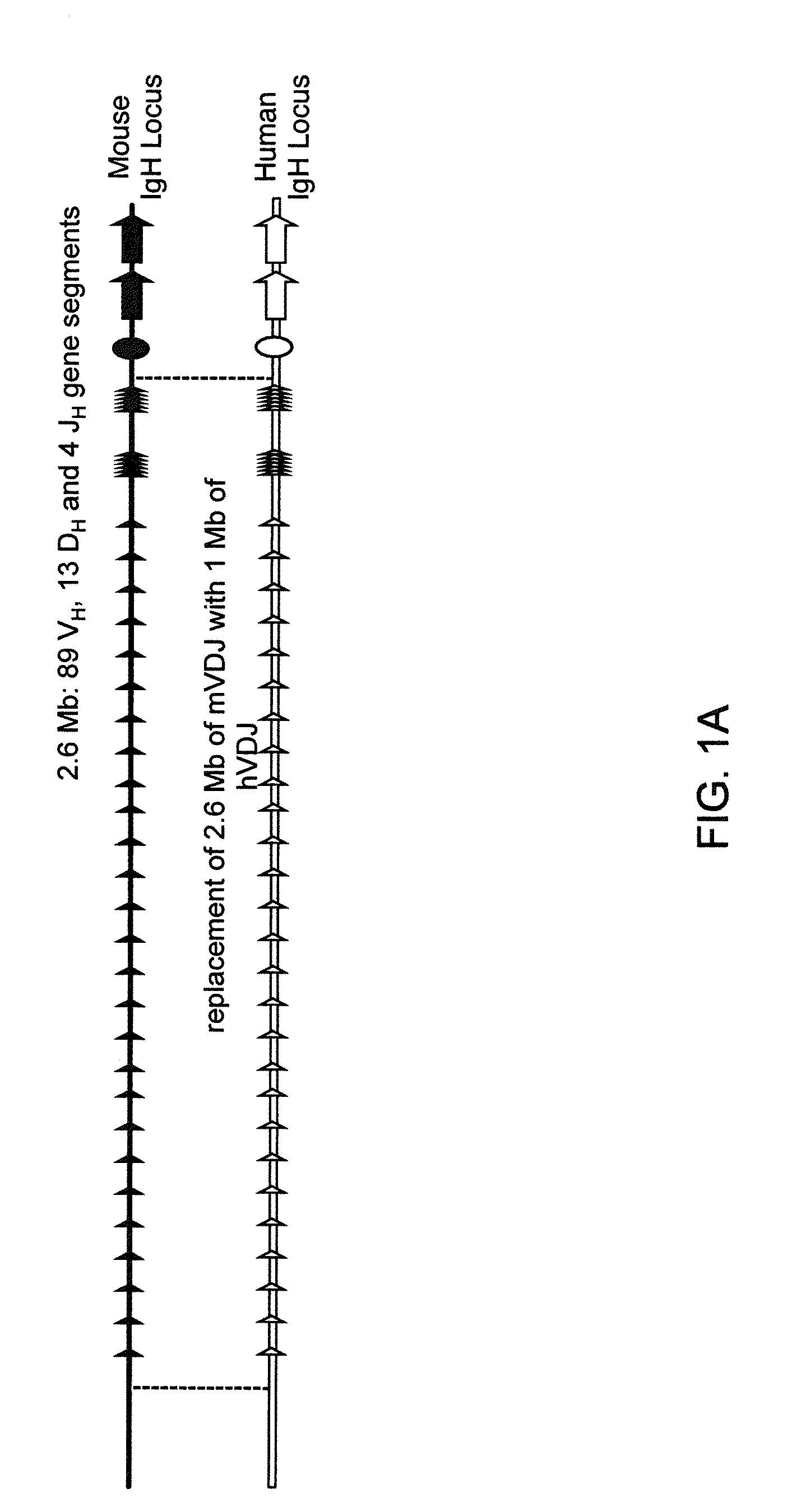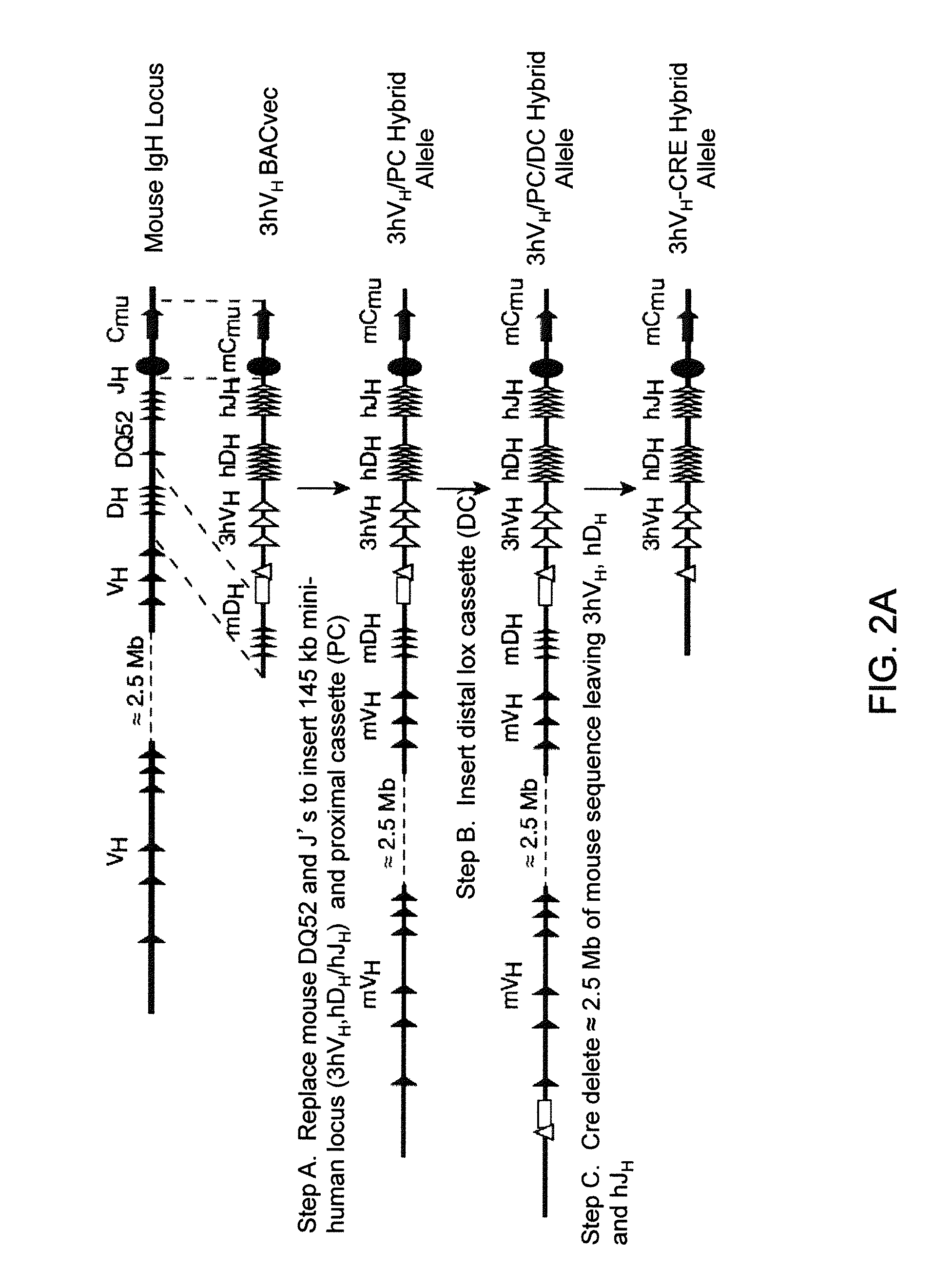Humanized light chain mice
a technology of light chain mice and mice, which is applied in the field of humanized light chain mice, can solve the problems of unsatisfactory anti-mouse antibody therapeutics, unsatisfactory long-term treatment regimens, and mice with substantial problems with their immune systems, so as to improve fertility, restore fertility, and reduce the effect of fertility
- Summary
- Abstract
- Description
- Claims
- Application Information
AI Technical Summary
Benefits of technology
Problems solved by technology
Method used
Image
Examples
example 1
Humanization of Mouse Immunoglobulin Genes
[0590]Human and mouse bacterial artificial chromsomes (BACs) were used to engineer 13 different BAC targeting vectors (BACvecs) for humanization of the mouse immunoglobulin heavy chain and κ light chain loci. Tables 1 and 2 set forth detailed descriptions of the steps performed for the construction of all BACvecs employed for the humanization of the mouse immunoglobulin heavy chain and κ light chain loci, respectively.
[0591]Identification of Human and Mouse BACs.
[0592]Mouse BACs that span the 5′ and 3′ ends of the immunoglobulin heavy chain and κ light chain loci were identified by hybridization of filters spotted with BAC library or by PCR screening mouse BAC library DNA pools. Filters were hybridized under standard conditions using probes that corresponded to the regions of interest. Library pools were screened by PCR using unique primer pairs that flank the targeted region of interest. Additional PCR using the same primers was performed t...
example 2
Generation of Fully Humanized Mice by Combination of Multiple Humanized Immunoglobulin Alleles
[0611]At several points, ES cells bearing a portion of the human immunoglobulin heavy chain or κ light chain variable repertoires as described in Example 1 were microinjected and the resulting mice bred to create multiple versions of VELOCIMMUNE® mice with progressively larger fractions of the human germline immunoglobulin repertoires (Table 5; FIGS. 5A and 5B). VELOCIMMUNE® 1 (V1) mice possess 18 human VH gene segments and all of the human DH and JH gene segments combined with 16 human Vκ gene segments and all the human Jκ gene segments. VELOCIMMUNE® 2 (V2) and VELOCIMMUNE® (V3) mice have increased variable repertoires bearing a total of 39 VH and 30 Vκ, and 80 VH and 40 Vκ, respectively. Since the genomic regions encoding the mouse VH, DH and JH gene segments, and Vκ and Jκ gene segments, have been completely replaced, antibodies produced by any version of VELOCIMMUNE® mice contain human ...
example 3
Lymphocyte Populations in Mice with Humanized Immunoglobulin Genes
[0613]Mature B cell populations in the three different versions of VELOCIMMUNE® mice were evaluated by flow cytometry.
[0614]Briefly, cell suspensions from bone marrow, spleen and thymus were made using standard methods. Cells were resuspended at 5×105 cells / mL in BD Pharmingen FACS staining buffer, blocked with anti-mouse CD16 / 32 (BD Pharmingen), stained with the appropriate cocktail of antibodies and fixed with BD Cytofix™ all according to the manufacturer's instructions. Final cell pellets were resuspended in 0.5 mL staining buffer and analyzed using a BD FACSCALIBUR™ and BD CELLQUEST PRO™ software. All antibodies (BD Pharmingen) were prepared in a mass dilution / cocktail and added to a final concentration of 0.5 mg / 105 cells. Antibody cocktails for bone marrow (A-D) staining were as follows: A: anti-mouse IgMb-FITC, anti-mouse IgMa-PE, anti-mouse CD45R(B220)-APC; B: anti-mouse CD43(S7)-PE, anti-mouse CD45R(B220)-APC...
PUM
| Property | Measurement | Unit |
|---|---|---|
| nucleic acid | aaaaa | aaaaa |
| volume | aaaaa | aaaaa |
| time | aaaaa | aaaaa |
Abstract
Description
Claims
Application Information
 Login to View More
Login to View More - R&D
- Intellectual Property
- Life Sciences
- Materials
- Tech Scout
- Unparalleled Data Quality
- Higher Quality Content
- 60% Fewer Hallucinations
Browse by: Latest US Patents, China's latest patents, Technical Efficacy Thesaurus, Application Domain, Technology Topic, Popular Technical Reports.
© 2025 PatSnap. All rights reserved.Legal|Privacy policy|Modern Slavery Act Transparency Statement|Sitemap|About US| Contact US: help@patsnap.com



